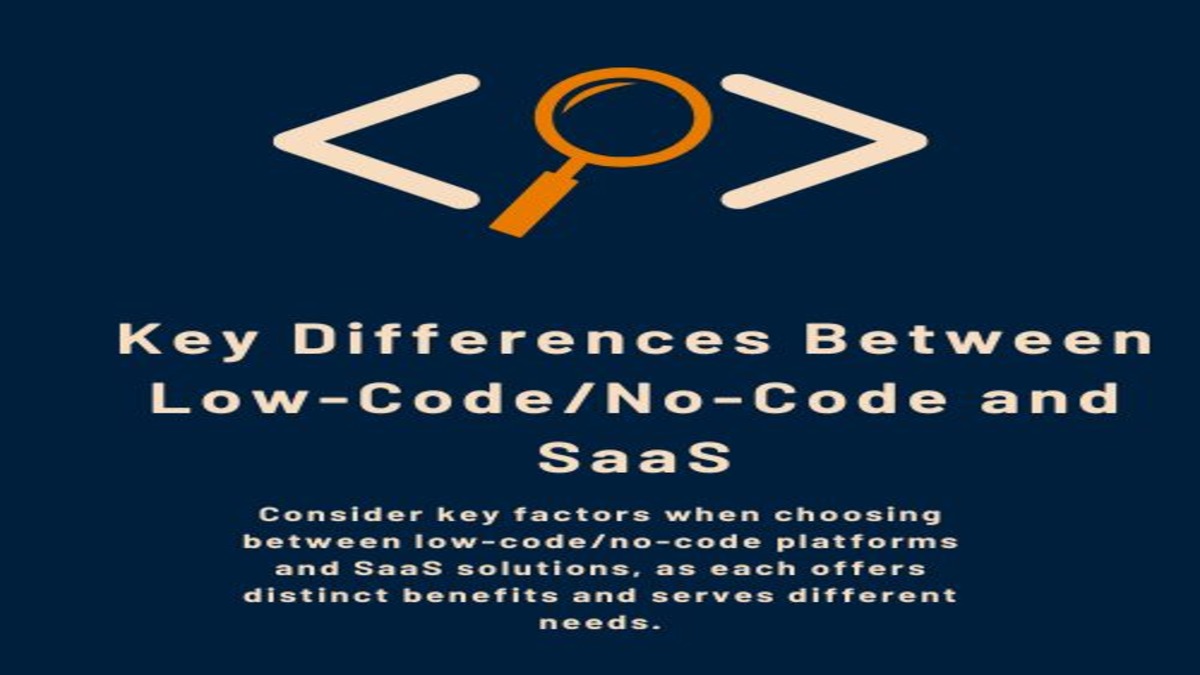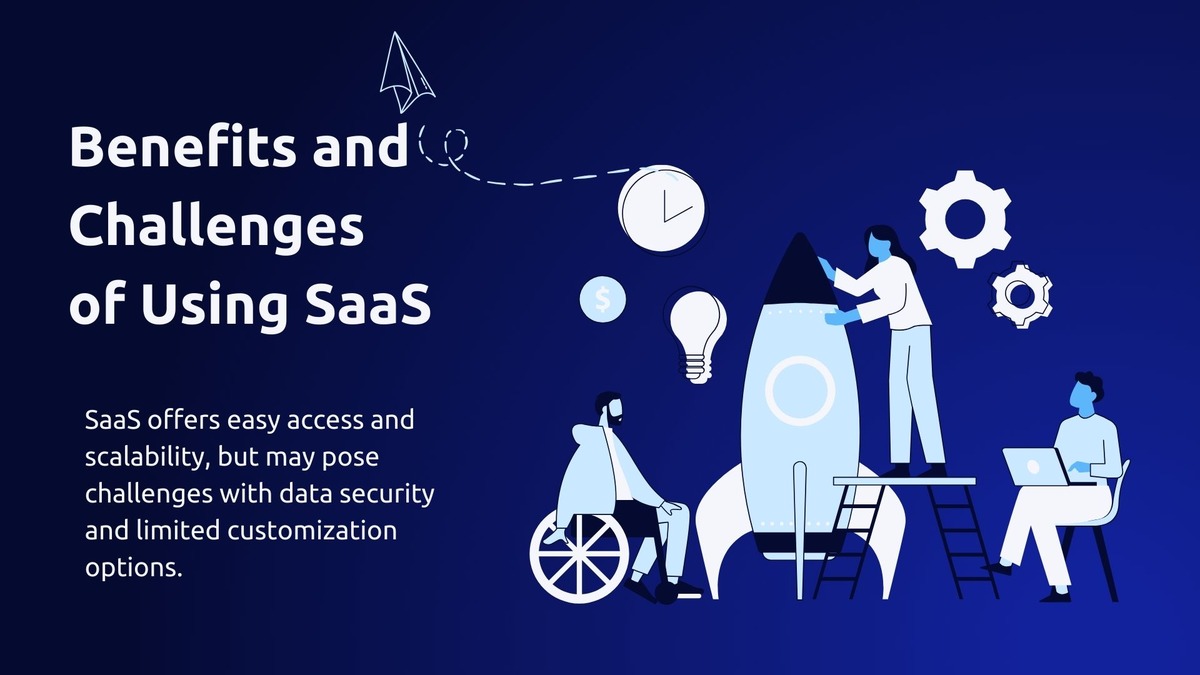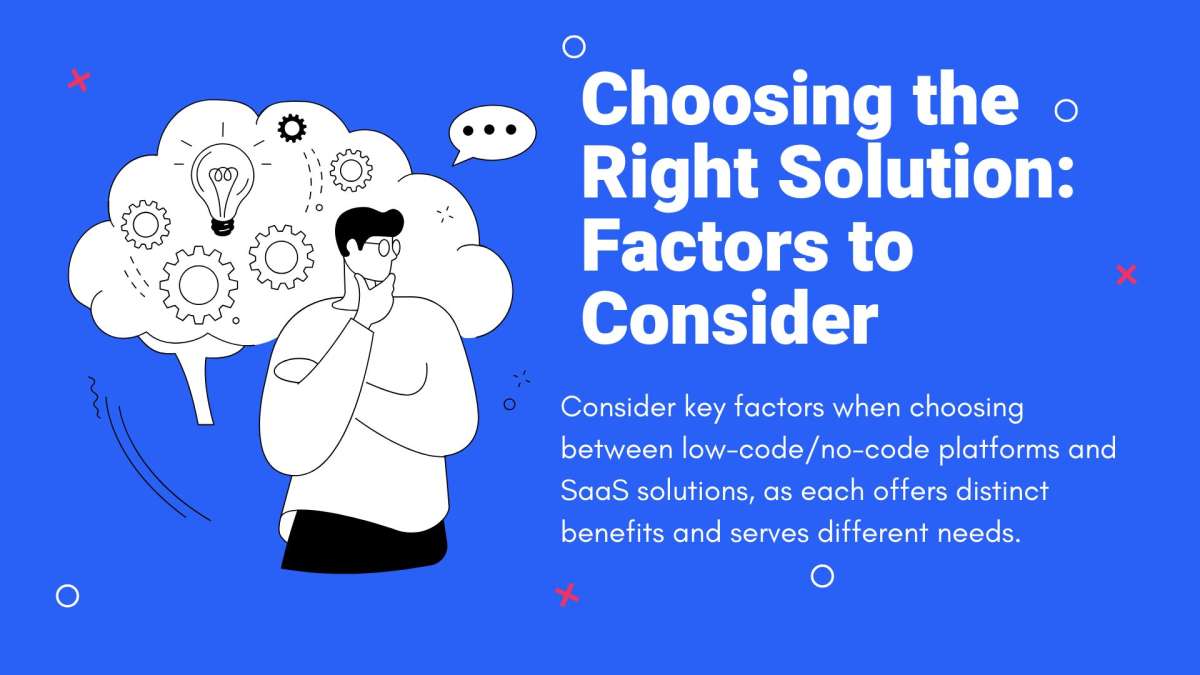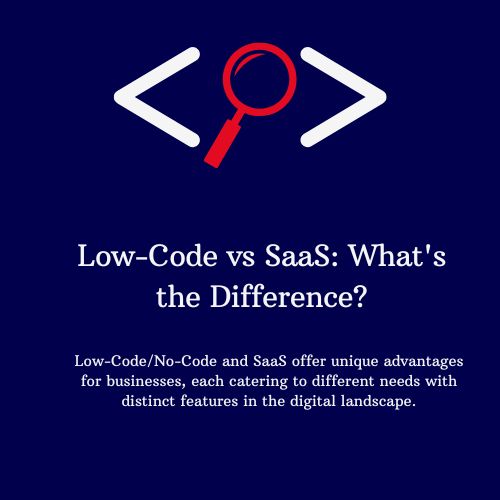In today’s fast-paced digital landscape, businesses are always on the lookout for efficient, cost-effective solutions to streamline their operations. Two buzzwords you’ll often hear in this context are Low-Code/No-Code vs Software as a Service (SaaS). While both offer unique advantages, they serve different needs and come with distinct features.
Low-Code/No-Code vs SaaS: Benefits
-
Low-Code/No-Code Platforms
Low-Code/No-Code Platforms are tools that allow users to create applications with minimal manual coding. Low-code platforms provide a graphical user interface with drag-and-drop components, making it easier for professional developers to speed up application development. No-code platforms go a step further, enabling even those without technical expertise to build functional applications. This democratization of app development empowers small businesses and large enterprises alike to innovate quickly without extensive IT resources.
-
Understanding Software as a Service (SaaS)
On the other hand, **SaaS (Software as a Service)** is a cloud-based service where instead of downloading software on your desktop PC or business network to run and update, you access an application via an internet browser. This model allows businesses to use software on a subscription basis, which eliminates the need for rigorous maintenance and hefty upfront costs. Popular SaaS applications include CRM systems like Salesforce, collaboration tools like Slack, and project management software like Asana.
-
Low-Code/No-Code VS SaaS
While both Low-Code/No-Code platforms and SaaS aim to make business operations more agile, they serve different functions. Low-Code/No-Code tools are more focused on enabling custom application development without heavy coding. Meanwhile, SaaS provides ready-to-use software solutions that can be accessed online, freeing you from extensive installation and maintenance tasks. Understanding these fundamental differences is crucial for businesses looking to implement the best solution for their specific needs.
Key Differences Between Low-Code/No-Code and SaaS

When distinguishing between Low-Code/No-Code (LCNC) platforms and Software as a Service (SaaS), understanding their core functionalities and use cases is essential.
-
Low-Code/No-Code Platforms:
Low-Code/No-Code platforms enable users to create custom applications with minimal to no programming knowledge. They offer drag-and-drop interfaces, pre-built templates, and automation tools to simplify the development process. Ideal for rapid application development, LCNC platforms empower non-developers and business users to build and deploy apps quickly, reducing dependency on IT departments.
-
Software as a Service (SaaS):
In contrast, SaaS delivers ready-made software solutions over the internet, allowing businesses to access applications without the need for complex installations or infrastructure management. SaaS providers handle all maintenance, updates, and security, offering a hassle-free user experience. Popular examples include CRM tools like Salesforce, productivity suites like Google Workspace, and collaboration platforms like Slack.
-
Customization and Flexibility:
A key difference lies in customization and flexibility. LCNC platforms are suited for organizations needing tailored solutions that align closely with specific workflows or unique business models. SaaS, however, is ideal for standard applications addressing common business needs without requiring much customization.
-
Scalability and Control:
Scalability and control also differ between the two. LCNC platforms offer more control over application features and functionality, while SaaS provides scalability without the need for in-house resources to manage server loads or software updates.
Understanding these differences will help you choose the best solution for your business needs, whether it’s the flexibility of custom apps through LCNC or the convenience of ready-to-use SaaS tools. Consider your specific requirements, available resources, and long-term goals when making this important decision.
Advantages and Limitations of Low-Code/No-Code

Low-code and no-code platforms have gained substantial traction in recent years, promising to revolutionize how businesses handle software development. These platforms are designed to allow users to create applications quickly with minimal hand-coding, using drag-and-drop interfaces and pre-built components.
Advantages
- Speed and Efficiency: One of the most notable benefits is the ability to develop applications rapidly. Businesses can shorten their development cycles from months to weeks, or even days.
- Cost-Effective: Since low-code and no-code platforms reduce the need for large development teams, they can be more budget-friendly and accessible for smaller businesses or startups.
- Empower Non-Developers: These platforms enable business analysts, project managers, and other non-technical staff to contribute to application development. This democratization of development can lead to more innovative solutions.
- Flexibility and Scalability: Modern low-code and no-code platforms are scalable, allowing businesses to start small and expand as needed. This flexibility is crucial for adapting to changing market conditions.
Limitations
- Customization Constraints: Although these platforms are versatile, they are not limitless. Highly specific or complex application requirements might still need traditional development.
- Performance Issues: Applications built on low-code or no-code platforms can sometimes face performance bottlenecks, especially if not optimized correctly.
- Security Risks: As with any software, applications built quickly might overlook critical security features, putting sensitive data at risk.
- Vendor Lock-In: Relying heavily on a low-code or no-code platform can create dependency on the vendor’s ecosystem, making it challenging to switch to more traditional solutions later.
In summary, low-code and no-code platforms offer a blend of speed, cost-effectiveness, and accessibility but come with their own set of limitations. Understanding these can help businesses make more informed decisions and leverage these tools effectively.
Benefits and Challenges of Using SaaS

Software as a Service (SaaS) offers a myriad of advantages that make it an appealing choice for businesses of all sizes.
- Cost-Effectiveness: One of the primary benefits is its cost-effectiveness. SaaS solutions usually operate on a subscription model, eliminating the need for hefty upfront investments in hardware and software. This pay-as-you-go approach allows companies to better manage their budgets and only pay for what they need.
- Accessibility: Another significant advantage is accessibility. SaaS applications are typically cloud-based, which means they can be accessed from anywhere with an internet connection. This flexibility is particularly beneficial for remote work and businesses with multiple locations.
- Maintenance and Security Management: Furthermore, SaaS providers handle all maintenance, updates, and security, freeing up your internal IT resources for other critical tasks.
- Data Security Concerns: However, SaaS is not without its challenges. One of the main concerns is data security. Since your data is stored off-premises, you are reliant on the vendor’s security measures. This makes it crucial to choose a reputable provider with strong security protocols.
- Limited Customization: Additionally, SaaS solutions may offer limited customization compared to on-premises software. This can be a drawback for businesses with unique needs that require tailored features.
- Vendor Lock-In: Another potential issue is vendor lock-in. Moving from one SaaS provider to another can be complicated and costly, especially if the data and applications are deeply integrated into your business processes.
In summary, while SaaS offers considerable benefits such as cost savings, accessibility, and ease of maintenance, it also comes with challenges like data security concerns, limited customization, and the risk of vendor lock-in. Evaluating these factors can help you make an informed decision about whether SaaS is the right choice for your business.
Choosing the Right Solution: Factors to Consider

When deciding between low-code/no-code platforms and Software-as-a-Service (SaaS) solutions, several distinct factors should be taken into account
-
Evaluating Business Needs and Objectives.
First, evaluate your business needs and objectives. Low-code/no-code platforms excel in providing customizable applications tailored to specific requirements. They enable teams to build and modify software quickly without extensive programming knowledge. This can be a boon for businesses looking to innovate rapidly and adapt to changing market demands.
-
Customization vs. Ready-to-Use Solutions
On the other hand, SaaS solutions are often more suitable for standard business functions like CRM, HR, or accounting, where the software needs do not require heavy customization. SaaS platforms are typically ready-to-use and often come with robust support and regular updates. This makes them ideal for organizations seeking reliable, out-of-the-box solutions with minimal maintenance.
-
Budget Considerations
Budget constraints also play a significant role in your decision. Low-code/no-code platforms may have lower initial costs because you aren’t hiring a large team of developers. However, hidden costs like training and ongoing customizations can add up. SaaS solutions usually have predictable subscription fees, making financial planning easier.
-
Empowering In-House Expertise
Lastly, consider your in-house expertise. Low-code/no-code solutions empower non-technical staff to contribute to software development projects, fostering collaboration and speeding up delivery times. If your team lacks technical prowess, these platforms can be an effective way to bridge the skills gap. Conversely, SaaS solutions require minimal technical know-how, reducing the learning curve and ensuring that your team can hit the ground running.
-
Making the Right Choice
Choosing between low-code/no-code and SaaS ultimately hinges on your specific needs, financial considerations, and available expertise. Weigh these factors carefully to make a decision that will best support your business objectives and drive long-term success.
Conclusion: Making the Best Choice for Your Needs
Choosing between low-code/no-code and SaaS requires a thorough understanding of your specific business needs, technical capabilities, and long-term goals.
Low-Code/No-Code Platforms: Flexibility and Customization
Low-code/no-code platforms are ideal if you need to develop custom applications quickly with minimal coding expertise. They offer flexibility, enabling you to tailor solutions to unique business processes, but they might require some initial learning for leveraging all features effectively.
SaaS Solutions: Ready-to-Use and Industry-Standard
On the other hand, Software as a Service (SaaS) solutions come as ready-to-use applications, ideal for businesses seeking instant deployment with minimal setup time. SaaS typically encompasses industry best practices and robust security measures, making it an attractive choice for many organizations. However, it might lack the customization depth that some businesses need.
Key Considerations for Choosing the Right Solution
When considering the best choice, assess factors such as budget, time constraints, staff skills, and the specific needs of your business operations. For example, small businesses with limited coding knowledge might find SaaS more immediately valuable, while larger enterprises with unique operational requirements may benefit from the customization capabilities of low-code/no-code platforms.
Aligning Technology with Business Objectives
Ultimately, the goal is to select a solution that aligns well with your business objectives while offering scalability and efficiency. Whether you lean towards low-code/no-code for its adaptability or prefer the straightforwardness of SaaS, making an informed choice will ensure you leverage technology to drive growth and innovation effectively.
Read More: Top 10 Popular SaaS Marketing Blogs in 2024

